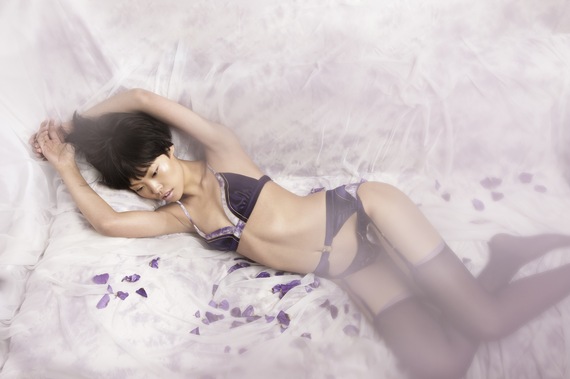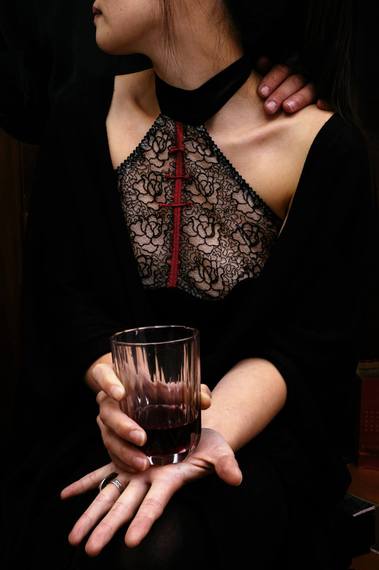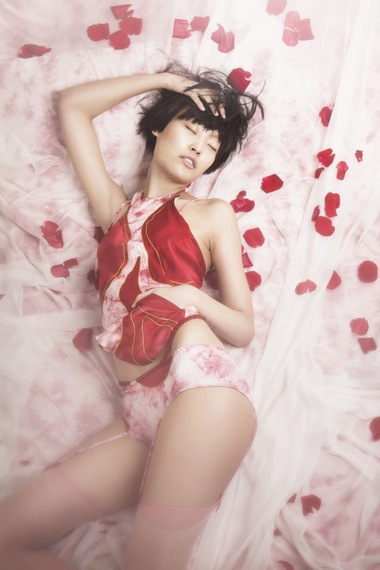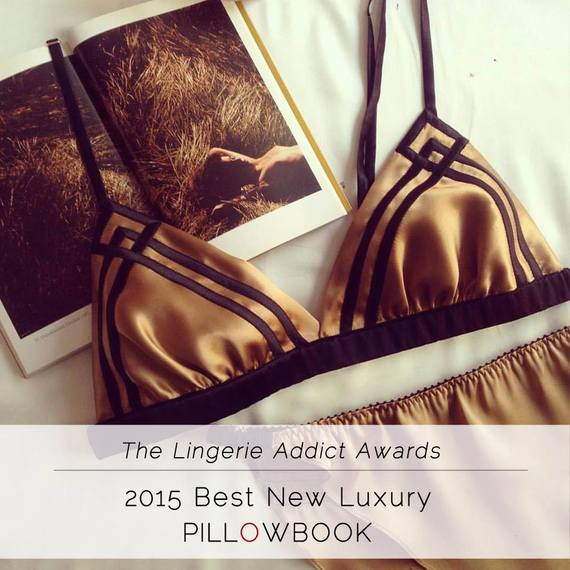Irene Lu is this founder and designer of Pillowbook, a handcrafted, custom-made lingerie atelier in Beijing, China. Lu creates body-positive, luxury intimate apparel with designs that embrace real sizes instead of falling prey to the unrealistic standards that most consumer-driven fashion lines cater to. In a world of throwaway fashion, Pillowbook brings exquisite detail, craftsmanship and cultural relevance back to lingerie and aims to boost women's self esteem through doing so.
MW: Can you tell me a little bit about your background? You grew up in Taipei, went to school in New York and run your business out of Beijing.
IL: My parents are Taiwanese and I was born in NYC. I grew up in Taiwan before attending the NY Fashion Institute of Technology to specialize in intimate apparel. The idea behind PILLOWBOOK came to me when I was 23 but it wasn't until 5 years later that it launched. I still remember sketching the logo on a black Moleskin pad and showing you at the beauty counter!
About the logo! Think you'd appreciate the meaning... At first glance, it's a flower, but with a little imagination, it resembles bosoms or hips or a woman's erogenous slit. That little droplet of nectar dripping from the flower, you get the idea...
MW: What made you decide to return to China to start your business?
IL: In 2009, a production designer in China offered me a job as his costume manager. I practically bought the next flight to Beijing because who wouldn't take a job working alongside an Oscar winner? It was a really intense learning experience but I quit after few years to spend time with my sister in Taiwan. She was going through chemo for breast cancer and it was hard. It was that environment that served as a reminder that anything can happen tomorrow which gave me the push to take the leap.
There was also a very sexy Frenchie waiting for me back in Beijing so that helped too.
MW: For those who have never heard of one, what is a Pillowbook? Who made them? Who had them? And what sort of purpose did they serve?
IL: Everyone knows the Kama Sutra and Shunga but few have heard of the Chinese version. Not even the Chinese know about it! Contrary to popular belief, each version served a purpose more than just sexual stimulation. Indian Kama Sutra is based on the principles of tantric sex to discover spirituality through prolonged ecstasy. It also teaches the importance of equal participation of both partners (we all know too well about giving but not receiving, amiright?) and practicing multiple positions to stimulate and benefit the entire body (so it's not only missionary every time) Japanese Shungas were placed inside armoires and chests during combat as talismanic powers of protection. They were also popular amongst woman too as they carried them about, hiding naughty scrolls of erotica in their kimonos. Plenty of Shunga painters (usually from elite art schools) were commissioned by textile companies to paint on their most exquisite fabric, on layers upon layers of kimono robes, the lovers were depicted. In the East, sex was perceived much more positively than the West and as a result, a lot of these objects were considered respectable and highly collectible art at some point.
Chinese pillow books were originally used to gift to young brides (mostly teens back in the day) to instruct what was to come on their wedding night. The pillow books were equivalent to sexual education, as the topic was not encouraged to be discussed openly. Pillowbooks came in paintings, scrolls, sculptures and etched wood or bamboo blocks. All were palm-sized, tiny enough to tuck away under a pillow. This concept inspired PILLOWBOOK to encourage and empower woman by exploring adventurous lovemaking.
MW: What's it like being a female business owner who handcrafts custom made intimate apparel in China? Is it something you can be open with everyone about or is it perceived as scandalous?
IL: Being a female in the lingerie industry comes as an advantage during fittings. Being a foreigner-owned business in China has its limitations such as the many language and cultural barriers. Starting an intimate apparel brand in China is nothing new as more than 70-80% of the world's intimate apparel is manufactured in China. The custom made part did raise eyebrows because there was a lot of speculation in the beginning about the Chinese consumer. Fortunately, by now, they have matured and it's actually shocking how attitudes changed almost overnight. Well-educated Chinese consumers do care about quality and meaning. They are bored with flashy logos, and are conscious of the effects of fast fashion. It's common to request customization in order to express individualism and of course, to up the prestige of the luxury experience.
MW: Where are the majority of your customers from?
IL: A lot of them are single, white-collar Chinese ladies in their late 20's to mid 30's who are well traveled and educated. Among Western buyers, 95% of them are French. One of my first customers was 60 something woman, born and raised in Beijing. She bought a dudou (traditional Chinese lingerie) because she wanted to experience a part of her culture that was abolished in previous generations. She immediately changed into her new purchase for the movie date with her husband that very night. It's hard to forget her; she giggled like a 13 year-old girl with a crush! Those are my favorite customers who purchase the dudou as a gesture of cultural pride, they add a deep personal value to each piece.
MW: How do you see lingerie as a tool to empower women?
IL: In Asia, there is a very unhealthy beauty standard which is that woman can only be desirable with DD+ breasts and Mt. Everest cleavage. Since it's not biologically common for the average Asian physique, 99.9% of the bras available are heavily padded. I've seen bras with 3 extra inserts, each cup, with a molded padded bra! The bra we choose to wear is very closely linked to the way we perceive ourselves. Likewise, the lingerie available on the shelf has an impact that serves to unconsciously conform us to society's expectations. So I made a promise to never design bust 'enhancing' bras so that a woman can avoid the trap of defining her worth by the size of her boobs.
It's why I'm obsessed with the dudou. It was originally worn tight to flatten the breasts for modesty. When Western influence displaced it with the bra we know of today, the exquisite dudou with such a rich cultural history, sadly turned into a cheap souvenir, almost overnight. This inspired me to modernize the ancient cultural staple and bring it back to the contemporary wardrobe. I've established a sizing system for bigger busts, as it was originally one petite size for all. I made adjustments to the fit so that it's worn to free the breasts and not flatten. It's a truly forgiving cut that flatters anyone and most importantly, it's so deliciously comfortable. I never feel like yanking it off ASAP like I do with a constricting underwired bra. I hate to sound like a saleswoman but with all honesty, the dudou has replaced all my bras. #freethenipple!
As a side note, it's not surprising that the dudou isn't taught in western lingerie classes, as the industry remains extremely Eurocentric.
MW: Tell me about the craft, the materials you use, the amount of time that goes into a custom order. . .
IL: Each collection is treated like erotic storytelling and I suppose this comes intuitively to me from working previously as a
costume designer for film and theater. Lingerie designers usually focus on the breasts and the storyline for lookbooks comes as an afterthought. It's the opposite for me; there's always a visual storyboard, usually inspired from traveling, churning in my head when I design. I take great consideration into the beauty of every nook and cranny of a woman's body. For me, the collarbone, the hip wings, the nape are so much more sensual than a deep cleavage.
Then it's the actual product development, which the most amount of time is invested in. Quality, details and finished execution are values I am (annoyingly) finicky about. Because of this, I don't pressure myself to create 2-4 collections a year as the industry expects. That pace of production is, in fact environmentally unfriendly and original ideas can rarely flourish under such pressure.
The 100% silks are from Hangzhou. Some of the smaller parts are from local markets, but the gunmetal and gold plated garter clips are imported from France. To minimize waste, every order is made-to-order allowing customers an experience to color customize their pieces. It's really incredible to see unexpected color combinations and so far, no two pieces have been alike. It shows how different everyone truly is! Each piece is handcrafted by one single couturier so it usually takes more than half a day for a bralet to 1.5 day for lounge pants. All of our scraps are always up-cycled into making a matching lingerie bag and gift for the client. All this magic happens in our little atelier space so that I can catch any mistakes.
To redefine the stereotypes, our labels state: "Proudly Made in China" and are autographed by the couturier herself.
Speaking of silk scraps... I don't have the heart to trash any 100% silk scraps, so after 2 years, there are enough to create an entire up-cycled collection. It's going to be so colorful!

You can read more about Pillowbook and Irene Lu's creations at http://www.love-pillowbook.com. To see images of her work, check out Pillowbook's Instagram page at https://www.instagram.com/love_pillowbook/.





